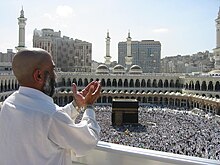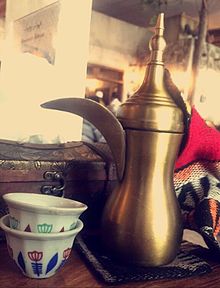News & Notice
Photo Gallery








SAUDI ARABIA
Culture
Saudi Arabia has centuries-old attitudes and traditions, often derived from Arab civilization. This culture has been heavily influenced by the austerely puritanical Wahhabiform of Islam, which arose in the eighteenth century and now predominates in the country. Wahhabi Islam has been called “the predominant feature of Saudi culture.
Religion in society
Islam is the state religion of Saudi Arabia and its law requires that all citizens be Muslims.[351] Neither Saudi citizens nor guest workers have the right of freedom of religion.[351] The official and dominant form of Islam in the kingdom – Wahhabism—arose in the central region of Najd, in the eighteenth century. Proponents call the movement “Salafism”,[329] and believe that its teachings purify the practice of Islam of innovations or practices that deviate from the seventh-century teachings of Muhammad and his companions. The Saudi government has often been viewed as an active oppressor of Shia Muslims because of the funding of the Wahabbi ideology which denounces the Shia faith. Prince Bandar bin Sultan, Saudi ambassador to the United States, stated: “The time is not far off in the Middle East when it will be literally ‘God help the Shia’. More than a billion Sunnis have simply had enough of them.” Saudi Arabia is one of the few countries that have “religious police” (known as Haia or Mutaween), who patrol the streets “enjoining good and forbidding wrong” by enforcing dress codes, strict separation of men and women, attendance at prayer (salat) five times each day, the ban on alcohol, and other aspects of Sharia (Islamic law). (In the privacy of the home behavior can be far looser, and reports from the Daily Mail and WikiLeaks indicate that the ruling Saudi Royal family applies a differen
Dress
Saudi Arabian dress strictly follows the principles of hijab (the Islamic principle of modesty, especially in dress). The predominantly loose and flowing, but covering, garments are suited to Saudi Arabia’s desert climate. Traditionally, men usually wear a white ankle length garment woven from wool or cotton (known as a thawb), with a keffiyeh (a large checkered square of cotton held in place by an agal) or a ghutra (a plain white square made of finer cotton, also held in place by an agal) worn on the head. For rare chilly days, Saudi men wear a camel-hair cloak (bisht) over the top. In public women are required to wear a black abaya or other black clothing that covers everything under the neck with the exception of their hands and feet, although most women cover their head in respect for their religion. This requirement applies to non-Muslim women too and failure to abide can result in police action, particularly in more conservative areas of the country. Women’s clothes are often decorated with tribal motifs, coins, sequins, metallic thread, and appliques.
Arts and entertainment
During the 1970s, cinemas were numerous in the Kingdom although they were seen as contrary to Wahhabi norms. During the Islamic revival movement in the 1980s, and as a political response to an increase in Islamist activism including the 1979 seizure of the Grand Mosque in Mecca, the government closed all cinemas and theaters. However, with King Abdullah’s reforms from 2005, some cinemas have re-opened,[386] including one in KAUST. From the 18th century onward, Wahhabi fundamentalism discouraged artistic development inconsistent with its teaching. In addition, Sunni Islamic prohibition of creating representations of people have limited the visual arts, which tend to be dominated by geometric, floral, and abstract designs and by calligraphy. With the advent of oil-wealth in the 20th century came exposure to outside influences, such as Western housing styles, furnishings, and clothes. Music and dance have always been part of Saudi life. Traditional music is generally associated with poetry and is sung collectively. Instruments include the rababah, an instrument not unlike a three-string fiddle, and various types of percussion instruments, such as the ?abl (drum) and the ?ar (tambourine). Of the native dances, the most popular is a martial line dance known as the ?ar?ah, which includes lines of men, frequently armed with swords or rifles, dancing to the beat of drums and tambourines. Bedouin poetry, known as naba?i, is still very popular.
Sport
Football is the national sport in Saudi Arabia. The Saudi Arabia national football team is considered as one of Asia’s most successful national teams, having reached a joint record 6 AFC Asian Cup finals, winning three of those finals (1984, 1988, and 1996) and having qualified for the World Cup four consecutive times ever since debuting at the 1994 tournament. In the 1994 FIFA World Cup under the leadership of Jorge Solari, Saudi Arabia beat both Belgium and Morocco in the group stage before falling to defeat Sweden in the round of 16. During the 1992 FIFA Confederations Cup, which was played in Saudi Arabia, the country reached the final, losing 1–3 to Argentina. Scuba diving, windsurfing, sailing and basketball are also popular, played by both men and women, with the Saudi Arabian national basketball team winning bronze at the 1999 Asian Championship.[389] More traditional sports such as horse racing and camel racing are also popular. A stadium in Riyadh holds races in the winter. The annual King’s Camel Race, begun in 1974, is one of the sport’s most important contests and attracts animals and riders from throughout the region. Falconry, another traditional pursuit, is still practiced
Cuisine
Saudi Arabian cuisine is similar to that of the surrounding countries in the Arabian Peninsula and the wider Arab world, and has influenced and been influenced by Turkish, Indian, Persian, and African food. Islamic dietary laws are enforced: pork is not allowed and other animals are slaughtered in accordance with halal. Kebabs and falafel are popular, as is shawarma (shawarma), a marinated grilled meat dish of lamb, mutton, or chicken. As in other Arab countries of the Arabian Peninsula, machbus (kabsa), a rice dish with lamb, chicken, fish or shrimp, is among the national dishes as well as the dish mandi (food). Flat, unleavened taboon bread is a staple of virtually every meal, as are dates, fresh fruit, yoghurt and (hummus. Coffee, served in the Arabic style, is the traditional beverage but tea and various fruit juices are popular as well.
Education
Education is free at all levels. The school system is composed of elementary, intermediate, and secondary schools. A large part of the curriculum at all levels is devoted to Islam, and, at the secondary level, students are able to follow either a religious or a technical track. The rate of literacy is 90.4% among males and is about 81.3% among females.[3] Classes are segregated by sex. Higher education has expanded rapidly, with large numbers of Universities and colleges being founded particularly since 2000. Institutions of higher education include the country’s first university, King Saud University founded in 1957, the Islamic University at Medina founded in 1961, and the King Abdulaziz University in Jeddah founded in 1967. King Abdullah University of Science and Technology, known as KAUST, founded recently in 2009. Other colleges and universities emphasize curricula in sciences and technology, military studies, religion, and medicine. Institutes devoted to Islamic studies, in particular, abound. Women typically receive college instruction in segregated institutions














